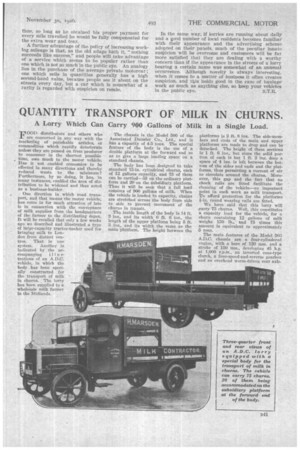QUANTITY TRANSPORT OF MILK IN CHURNS.
Page 67

If you've noticed an error in this article please click here to report it so we can fix it.
A Lorry Which Can Carry 900 Gallons of Milk in a Single Load.
FOOD distributors and others who are concerned in any way with the marketing of perishable articles, or commodities which rapidly deteriorate unless they are passed on from producer to consumer in the shortest possible time, owe much to the motor vehicle. Has it not enabled economies to be effected in many directions and thereby reduced waste to the minimum? Furthermore, by so doing, it has, in many instances, enabled the area of distribution to be widened and thus acted as a business-builder.
One direction in which road transport, and that means the motor vehicle, has come in for much attention of late is in connection with the conveyance of milk supplies from the headquarters of the farmer to the distributing depot. It will be recalled that only a few weeks ago we described and illustrated a type of large-capacity tractor-tanker used for
bringing milk to Lon' don from distant cen tres. That is one system. Another is indicated by the ac
eompanying illu s
trations of an A.D.C. vehicle, in which the body has been speci ally constructed for the transport of milk in churns. Pbe lorry has been supplied to a wholesale milk farmer in the Midlands. The chassis is the Model 506 of the Associated Daimler Co., Ltd.. and it has a capacity of 4-5 tons. The special feature of the body is the use of a double platform at the forward end so as to give a large loading space on a standard chassis.
The body has beendesigned to take standard 15-in. cylii dried churns, each of 12 gallons capacity, y, and 75 of them can be carried-55 on the ordinary platform and 20 on the subsidiary platform. Thus it will be seen that a full load consists of 900 gallons of milk. When the vehicle is loaded to capacity, chains are stretched across the body from side to side to prevent movement of the churns in transit.
The inside length of the body is 14 ft. 3 ins., and its width 6 ft. 6 ins., the length of the upper platform being 5 ft. 3 ins., and its width the same as the main platform. The height between the
platforms is 2 ft. S ins. The side-members and ends of the main and upper platforms are made to drop and can be detached. The height of these sections is 1 ft. 6 ins., but since the solid portion of each is but 1 ft. 2 ins, deep a space of 4 ins, is left between the bottom of the sides and ends and the platforms, thus permitting a current of air to circulate around the churns. Moreover, this gap and the fact that no chock rails are fitted facilitate the cleaning of the vehicle—an important point in such work as milk transport. To afford protection for the platforms fin, round wearing rails are fitted.
We have said that this lorry will .carry 75 churns. Well, this constitutes a capacity load for the vehicle, for a churn containing 12 gallons of milk weighs 150 lb., and 75 times this amount is equivalent to approximately 5 tons.
The main features of the Modell 505 A.D.C. chassis are a four-eylindered engine, with a bore of 120 mm. and a stroke of 150 min.. developing 45 h.p. at 1,000 r.p.m., an inverted cone-type clutch, a four-speed-and-reverse gearbox and an overhead worm-driven rear axle.




















































































































